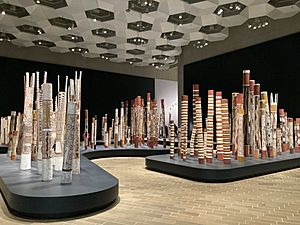Memorial pole facts for kids
A memorial pole, also known as a hollow log coffin or ḻarrakitj (pronounced 'larra-kitj'), is a special hollow tree trunk. It is decorated with beautiful designs. These poles are made by the Yolŋu and Bininj peoples. They live in Arnhem Land in the Northern Territory of Australia.
Long ago, these poles were used in burial ceremonies. They sometimes held the bones of people who had passed away. Today, they are mostly made as amazing works of art. The National Gallery of Australia has a famous display called Aboriginal Memorial. It includes 200 hollow log coffins. These were created by 43 different artists.

Contents
What Are Memorial Poles?
Memorial poles come in different sizes. Larger ones were used for burial ceremonies. Smaller ones might hold a person's bones. Families would keep these smaller logs for a while.
The poles can also represent the person who died. The designs on the pole often match the paintings put on the body during burial rites. Sometimes, there is a small painted or carved hole near the top. This hole is believed to let the soul of the person look out at the land.
Traditionally, these logs come from the stringybark tree. This tree is naturally hollowed out by termites.
The Art and Meaning of the Poles
The poles are painted with very detailed and complex designs. These designs are special to the deceased person's family group, called a clan. People believe these designs help guide the soul to its home. There, spirits and ancestors would recognize it.
The designs show a connection to ancestors. They sometimes link groups that share the same ancestral beings. The designs are filled in with a special cross-hatching style called rarrk.
As artworks, these poles celebrate ancestors and old cultural wisdom. They also act as a canvas for the artists' designs. Burial ceremonies are a way to celebrate life. The designs on the poles show identity and a deep connection to Country.
For a long time, Yolngu women were not allowed to paint sacred designs on larrakitj or bark paintings. But since 1970, many women have become skilled artists in this tradition.
Elders have supported making memorial poles as artworks. The Buku-Larrnggay Mulka Art Centre (Buku) creates these poles. They are sold to people all over the world.
Where Can You See Them?
Memorial poles are displayed in art galleries. Sometimes they are shown alone. Other times, they are grouped together. This grouping often follows Yolngu clan or kinship rules.
The Aboriginal Memorial
The National Gallery of Australia in Canberra has a special art display. It was first created in 1988. It is called the Aboriginal Memorial. This display has 200 hollow log coffins from Central Arnhem Land.
This memorial honors all the Indigenous Australians who died defending their land. This includes those who died since the colonisation of Australia began in 1788. It was made for everyone to see. A path goes through the display. It represents the Glyde River estuary. This river flows through the Arafura Swamp to the sea.
Forty-three artists from Ramingining created this exhibit. In June 2022, it was moved to a new, important spot in the gallery.
Other Exhibitions
In 2014, the art of Wukun Wanambi was shown at the British Museum. His work often features larrakitj.
In 2020, two museums, The Fralin Museum of Art and the Kluge-Ruhe Aboriginal Art Collection, had a joint exhibition. It was called Inside World: Contemporary Aboriginal Australian Memorial Poles. It was held at the Fralin in Charlottesville, Virginia. This exhibition included works by artists like John Mawurndjul, Djambawa Marawili, Gabriel Maralngurra, and Joe Guymala. This show made the poles even more popular in the art world.
There is also a "forest" of larrakitj at the Art Gallery of South Australia in Adelaide. It includes art by Gulumbu Yunupingu and Nawurapu Wunungmurra. Wunungmurra's larrakitj were also shown at the Tarnanthi art festival in 2017–2018.
In May 2021, two burial poles were put up at the Australian National University in Canberra. This was to remember a special event. Over 200 blood samples were returned to the Galiwin'ku people. These samples had been taken without their permission 50 years earlier. They were finally returned in 2019.
From December 2021 to April 2022, the National Gallery of Victoria had an exhibition. It was called Bark Ladies: Eleven Artists from Yirrkala. It featured larrakitj, bark paintings, and other works. Many women artists from Buku were included. These artists were sisters Nancy Gaymala Yunupingu, Gulumbu Yunupingu, Barrupu Yunupingu, Nyapanyapa Yunupingu, and Eunice Djerrkngu Yunupingu. Other artists included Dhuwarrwarr Marika, Malaluba Gumana, Naminapu Maymuru-White, Nonggirrnga Marawili, Dhambit Mununggurr, and Margaret Wirrpanda.
See also
- Treetrunk coffin


